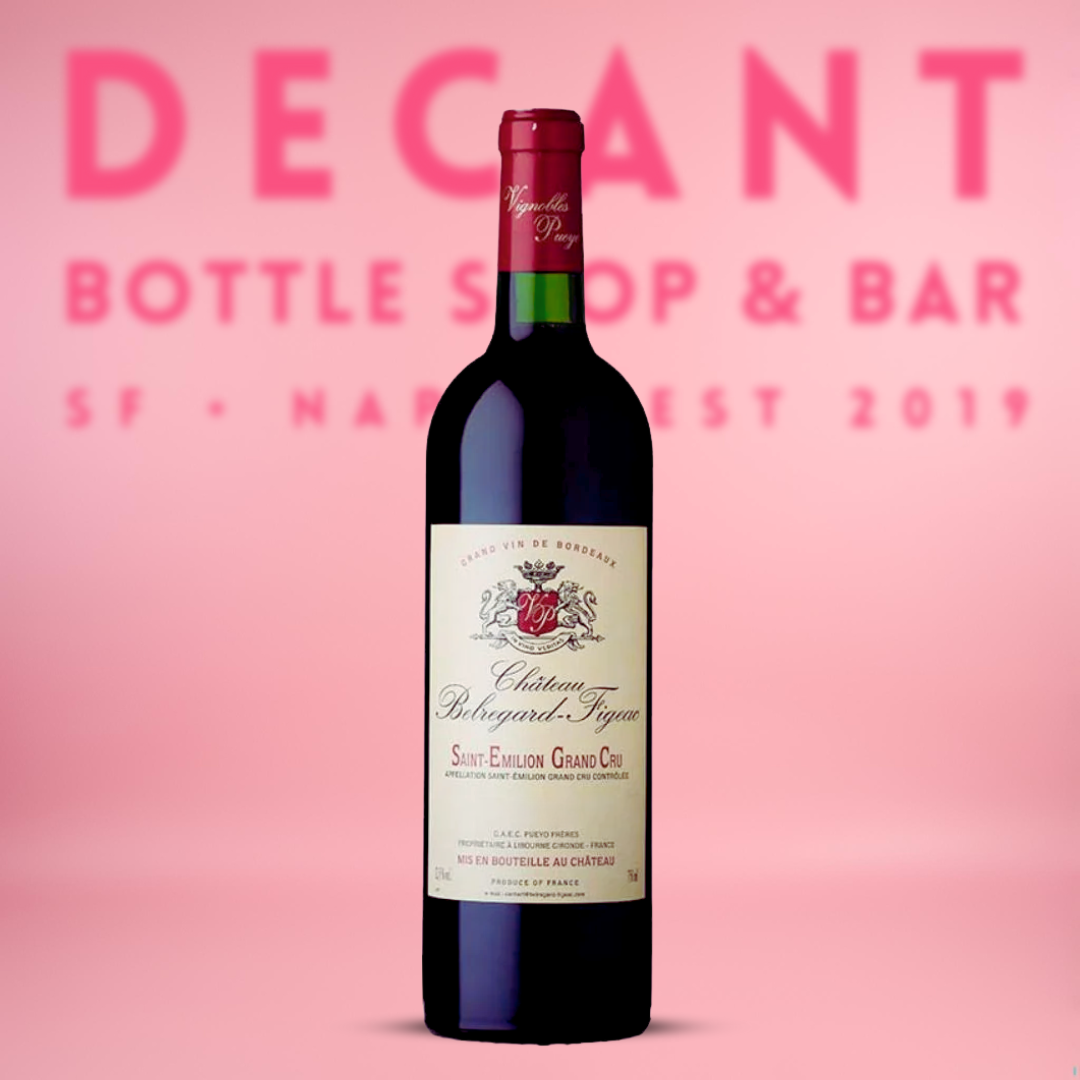Vignobles Pueyo Château Belregard-Figeac, Saint-Émilion Grand Cru, Bordeaux, France 2018
Pickup available at DECANT Napa - 2999 Solano, Napa, CA
Usually ready in 1 hour
Château Belregard-Figeac is part of the Pueyo family’s Libournais holdings, a fifth-generation estate that balances classic Right Bank tradition with a restrained, terroir-driven approach under winemaker Christophe Pueyo. Farming has been organic for over a decade, with recent biodynamic adaptations further emphasizing purity and vineyard expression.
-
WINEMAKER: Christophe Pueyo (fifth generation of the Pueyo family)
-
FARMING: Certified organic by Ecocert since 2010; biodynamic practices implemented beginning in 2017.
-
VARIETY: Approximately 60% Merlot, 35% Cabernet Franc, 5% Cabernet Sauvignon.
- TERROIR: The estate’s parcels sit on gravel and clay soils bordering the Figeac plateau in Saint-Émilion, with vine ages averaging 40 years. The high gravel content contributes to structure and minerality, while the underlying clay supports moisture retention in warmer vintages.
- VINIFICATION: Grapes are hand-harvested and fully destemmed before a brief cold soak. Fermentation takes place spontaneously with native yeasts in a mix of concrete and stainless-steel vats. Maceration lasts about three to four weeks, managed with gentle pumpovers to avoid over-extraction and preserve freshness. Malolactic fermentation occurs naturally in the same tanks, and the wine is racked by gravity before aging.
- AGING: The wine matures for roughly eighteen months, divided between oak barrels and cement. About 25% of the blend rests in new French oak, another 25% in one-year-old barrels, and the remainder in cement tanks to maintain aromatic lift and fruit precision. It remains on fine lees through élevage and is bottled unfined and unfiltered with modest sulfur levels.
- TASTING NOTES: Aromas of red currant, cassis, and raspberry mingle with tobacco leaf, coffee, and graphite. The palate is supple and medium-bodied, defined by refined tannins, lively acidity, and a savory mineral finish characteristic of Saint-Émilion’s gravelly soils.
- FOOD PAIRINGS: Excellent with roasted lamb, mushroom ragù, duck breast, or dry-aged ribeye. Also pairs beautifully with truffle dishes and aged cheeses.
Château Belregard-Figeac is part of the Pueyo family’s Libournais holdings, a fifth-generation estate that balances classic Right Bank tradition with a restrained, terroir-driven approach under winemaker Christophe Pueyo. Farming has been organic for over a decade, with recent biodynamic adaptations further emphasizing purity and vineyard expression.
-
WINEMAKER: Christophe Pueyo (fifth generation of the Pueyo family)
-
FARMING: Certified organic by Ecocert since 2010; biodynamic practices implemented beginning in 2017.
-
VARIETY: Approximately 60% Merlot, 35% Cabernet Franc, 5% Cabernet Sauvignon.
- TERROIR: The estate’s parcels sit on gravel and clay soils bordering the Figeac plateau in Saint-Émilion, with vine ages averaging 40 years. The high gravel content contributes to structure and minerality, while the underlying clay supports moisture retention in warmer vintages.
- VINIFICATION: Grapes are hand-harvested and fully destemmed before a brief cold soak. Fermentation takes place spontaneously with native yeasts in a mix of concrete and stainless-steel vats. Maceration lasts about three to four weeks, managed with gentle pumpovers to avoid over-extraction and preserve freshness. Malolactic fermentation occurs naturally in the same tanks, and the wine is racked by gravity before aging.
- AGING: The wine matures for roughly eighteen months, divided between oak barrels and cement. About 25% of the blend rests in new French oak, another 25% in one-year-old barrels, and the remainder in cement tanks to maintain aromatic lift and fruit precision. It remains on fine lees through élevage and is bottled unfined and unfiltered with modest sulfur levels.
- TASTING NOTES: Aromas of red currant, cassis, and raspberry mingle with tobacco leaf, coffee, and graphite. The palate is supple and medium-bodied, defined by refined tannins, lively acidity, and a savory mineral finish characteristic of Saint-Émilion’s gravelly soils.
- FOOD PAIRINGS: Excellent with roasted lamb, mushroom ragù, duck breast, or dry-aged ribeye. Also pairs beautifully with truffle dishes and aged cheeses.
